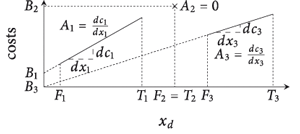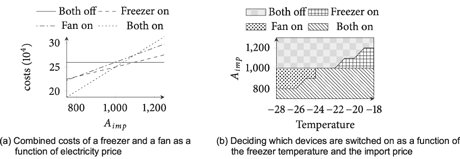by Albert Molderink, Vincent Bakker and Gerard J.M. Smit
Steering a heterogeneous set of devices in a Smart Grid using cost functions: Demand Side Management (DSM) is an important element in smart grids. DSM is already in operation for large consumers, but thorough research is required into DSM on a building level within the distribution grid.
Decreasing flexibility on the production side of the supply chain, caused by a growing share of (uncontrollable) renewable generation, and an increasing load on the grid, due to consumer side developments as distributed generation and electrical cars, require flexibility on the consumer side of the supply chain to maintain a stable and affordable energy supply: Demand Side Management (DSM). A range of DSM methodologies have been proposed [1], based around strategies to optimize consumers’ consumption patterns and to exploit the potential of buffers and distributed generation. Most proposed methodologies optimize at a device level. The problem with this approach is that it introduces device-level constraints, resulting in a very complex optimization problem that is subject to many constraints. The complexity can be overcome by using generic functions expressing the device constraints and ranking, in order of preference, different options relating to the device.
Cost functions, which reduce the complexity of the optimization problem to a cost optimization problem with a limited number of constraints [2], express the relationship between energy price and level of consumption (Xd). We use partial linear non-continuous functions (see Figure 1). The outcome of such an optimization problem is an energy price (Aimp), which in combination with the cost function of the devices specifies the resulting dispatch for each device.

Figure 1: Example cost function
In all control methodologies, a decision for every device is taken, often in a hierarchical way to maintain scalability. Therefore, the cost functions of multiple devices need to be aggregated. Adding the cost functions of two devices means adding two partial linear non-continuous functions. The sum of the two functions consists of all possible combinations of the individual parts of the two individual functions (see Figure 2), where some combinations may not be applicable.

Figure 2: Combining two non-continuous, partial linear functions
We use a freezer and a fan to demonstrate how the cost functions of two consuming devices are combined. The energy price determines which option (eg switching on/off) will be chosen for each device; costs can be calculated based on the energy price, where the cheapest option will be chosen. Figure 3(a) shows the total costs for the possible scenarios as a function of energy price: when the energy price is lower than 1000, both devices will be switched on (the line with the lowest cost will be chosen); when the energy price lies between 1000 and 1100 only the freezer will be switched on; and when the price is higher than 1100 both devices will be switched off. So, in the combined cost function with one steering signal for both devices, the fan cannot be switched on while the freezer is switched off. The cost function of the freezer depends on the temperature of the freezer. Figure 3(b) shows multiple values of the energy price and multiple temperatures for the freezer when both the fan and the freezer are switched on, when only the freezer is switched on, when only the fan is switched on and when both devices are switched off.

Figure 3: Combined behaviour of a freezer and a fan
As a second example, Figure 4(a) shows the cost functions of three electricity supply sources (production): electricity import, a generator and a battery. The battery is the cheapest source (when it is full), but has a limited capacity. The combined function (Figure 4(b)), shows which (mix of) source(s) is used for a given level of electricity consumption. When the above mentioned consumers (fan and freezer) and sources (import, generator and battery) are combined, the amount of consumption depends on the price, but the price (per unit) depends on the amount of consumption. For example, matching the above mentioned costs for demand and supply, both the fan and the battery would be supplied since the battery can deliver enough cheap electricity for both. However, when the capacity of the buffer would have been limited on 100W, only the freezer would have been supplied.

Figure 4: Combination of multiple electricity supply sources
In conclusion, the cost functions for devices in combination with the options per device are a very flexible way to express the status of the device and desirability of different options. The control methodologies act on a homogeneous set of cost functions that keeps the algorithms much easier and less computationally intensive. Cost functions of multiple devices can be combined into one cost function to aggregate them for scalability, even when consumption and production are combined. A single energy price for a group of devices (combined cost functions) is a trade-off between complexity and flexibility: it disables certain combination of options and may consequently limit the application of a single price for steering. For more information, an example of steering a group of 400 houses with multiple devices and different control methodologies can be found in [3].
References:
[1] A. Molderink, et al: “Comparing Demand Side Management approaches”, international conference on Innovative Smart Grid Technologies Europe, October 2012
[2] A. Molderink, et al: “Management and control of domestic smart grid technology”, IEEE transactions on Smart Grid, vol. 1, no. 2, pp. 109–119, September 2010
[3] F. Claessen: “Smart grid control,” master thesis, TU Delft, the Nether- lands, 2012.
Please contact:
Gerard J.M. Smit
University of Twente, The Netherlands
E-mail:











